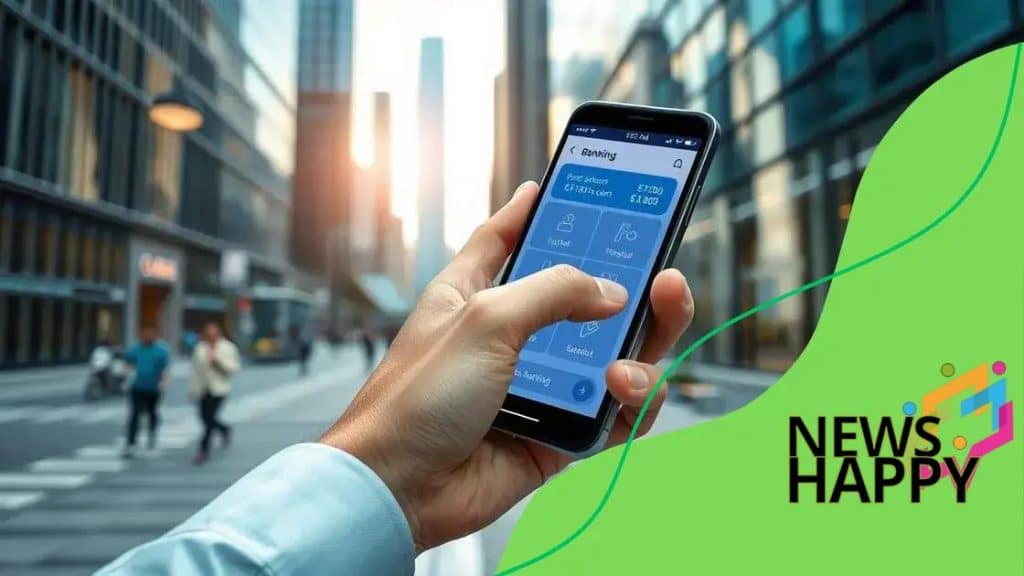The rise of mobile banking apps: revolutionizing finance

Anúncios
The rise of mobile banking apps is revolutionizing finance by offering convenient, secure, and accessible banking solutions, especially in underserved areas globally.
The rise of mobile banking apps is transforming how we interact with our finances every day. Have you noticed how many people are now banking right from their smartphones? In this article, we’ll delve into the implications of this shift.
Anúncios
Understanding mobile banking apps
Understanding mobile banking apps is essential in today’s fast-paced world. These applications allow users to manage their finances from the comfort of their smartphones, making banking easier than ever.
Mobile banking apps offer a range of features that enhance user experience. Customers can check their balances, transfer funds, and pay bills all in one place. The convenience of accessing financial information anytime, anywhere is a game changer.
Key Features of Mobile Banking Apps
These apps come equipped with various features that cater to user needs:
Anúncios
- Account Management: Users can view their balances, transaction history, and account statements.
- Fund Transfers: Mobile banking allows for quick and easy transfers between accounts or to others.
- Bill Payments: Bills can be paid directly through the app, saving time and effort.
- Mobile Check Deposit: Users can deposit checks by simply taking a photo.
Security is another critical aspect of mobile banking apps. Banks implement advanced encryption protocols to keep user data safe. Features like biometric authentication, such as fingerprint or face recognition, provide additional layers of security to prevent unauthorized access.
The User Experience
The user experience in mobile banking is designed to be intuitive. Apps are generally straightforward, allowing users to navigate easily through various functionalities. However, challenges can still arise, such as connectivity issues or app glitches, which can disrupt access to banking services.
In conclusion, as we delve deeper into the world of mobile banking apps, it’s clear they revolutionize how we manage finances. Their features streamline banking processes and empower users to take control of their financial lives.
Advantages of mobile banking
There are several notable advantages of mobile banking that appeal to modern users. One major benefit is convenience; users can manage their finances from anywhere, at any time. This flexibility is particularly important in today’s busy world.
Key Benefits of Mobile Banking
Mobile banking offers various features that enhance the banking experience:
- 24/7 Access: Bank whenever you want without waiting in long lines.
- Quick Transactions: Easily transfer money, pay bills, and make purchases on the go.
- Real-Time Notifications: Get instant alerts about account activity, aiding budgeting and fraud detection.
- Cost-Effective: Many apps reduce or eliminate fees associated with traditional banking.
In addition to these practical benefits, mobile banking apps often provide enhanced user experiences. Many are designed for ease of use, allowing for quick navigation and straightforward access to information. For instance, users can view their account balances or recent transactions with just a few taps.
Another important aspect is the security features included in these apps. Most mobile banking platforms utilize multiple security measures, such as two-factor authentication, to protect user information. This gives users peace of mind while managing their finances digitally.
Changing Financial Habits
The rise of mobile banking is also changing how people manage their finances. Many users are now inclined to handle most transactions via their smartphones. This shift towards digital tools reflects a broader trend towards online convenience in all areas of life.
As mobile banking continues to evolve, new features and enhancements are introduced regularly, making it an increasingly appealing option for users.
Challenges facing mobile banking

While mobile banking has many benefits, it also faces several significant challenges that can affect user experience. One major issue is security. With the rise of cyber threats, users are often concerned about the safety of their personal and financial information.
Many banks implement strong security measures, but breaches can still occur, raising doubts in users’ minds. Trust in the app is essential for regular use, and any reported incidents can undermine this trust.
User Interface and Experience
Another challenge is the user interface. Some mobile banking apps can be complicated and difficult to navigate. Users expect a seamless experience, and any friction can lead to frustration and decreased usage. Clear layouts and intuitive designs are necessary for good user engagement.
- Complex Navigation: Users may struggle to find basic functions.
- Slow Loading Times: Apps that lag can make users abandon them.
- Inconsistent Features: Features may differ greatly between devices, leading to confusion.
- Customer Support: Limited or unhelpful support can leave users feeling stranded.
Additionally, technological issues can present challenges for mobile banking. For example, if a user’s phone or internet connection is unreliable, accessing their bank information can become problematic. Regular updates to the app are necessary to keep it functioning smoothly.
Finally, the digital divide affects the adoption of mobile banking in certain demographics. Older users may have difficulty adapting to technology, while some rural areas may lack internet coverage. Education and outreach are vital to ensuring everyone can enjoy the advantages of mobile banking.
The future of mobile banking technology
The future of mobile banking technology looks promising and full of advancements that can change how we manage our finances. As technology evolves, users can expect new features that enhance the banking experience.
One expected trend is the increased integration of artificial intelligence (AI). AI can help banks offer personalized services. For example, users might receive tailored financial advice based on spending habits. This level of customization will make mobile banking more user-friendly.
Innovative Features on the Horizon
Mobile banking apps are likely to introduce several innovative features that will improve functionality:
- Voice-Activated Banking: Users will be able to conduct transactions and inquiries using voice commands.
- Blockchain Technology: This technology could provide greater security and transparency for transactions.
- Augmented Reality (AR): Users might visualize their savings goals and financial data in new, interactive ways.
- Enhanced Security Measures: With growing concerns about cybersecurity, banks will implement advanced security protocols to protect user data.
Another exciting aspect of the future of mobile banking is the growing number of partnerships between banks and fintech companies. These collaborations will lead to more innovative solutions and greater competition in the market, ultimately benefiting the customers.
As mobile banking continues to grow, users will also see an increase in the accessibility of services. More people will have the opportunity to engage in digital banking, regardless of their location or financial literacy. This push for inclusivity is essential for modern banking.
Global reach and impact of mobile banking apps
The global reach of mobile banking apps is truly remarkable, extending across various continents and demographics. These apps are not just limited to developed countries; they are making significant strides in developing nations as well.
In many parts of the world, mobile banking apps are essential for financial inclusion. For example, in regions where traditional banking infrastructure is lacking, these apps provide access to financial services through smartphones. This is especially important in rural areas where physical banks might be few and far between.
Impact on Developing Countries
Mobile banking has transformed economies in numerous developing countries:
- Increased Accessibility: Individuals can open accounts and manage funds without needing to visit a bank.
- Cost Savings: Users save money on travel and fees associated with visiting branches.
- Economic Growth: Easier access to financial services encourages entrepreneurship and boosts local economies.
- Remittances: Sending money across borders has become faster and more affordable, benefiting families who rely on support from abroad.
As mobile banking apps continue to expand their reach, the impact on global connectivity and trade is profound. Businesses can now easily transact on a global scale, making international commerce much more accessible.
The rise of mobile banking also drives competition among banks and fintech companies. This results in better services for customers, as companies strive to improve user experiences with innovative features and functionalities. Moreover, the increasing use of mobile banking fosters a tech-savvy culture, encouraging users to embrace other digital solutions.
Conclusion:
Mobile banking apps are transforming the way we manage our finances, offering significant benefits and facing challenges. Their global reach fosters financial inclusion, especially in underbanked regions. As technology advances, the features of these apps will become even more innovative and user-friendly. Despite the hurdles with security and usability, the future looks bright for mobile banking. It empowers users to handle their transactions conveniently and safely. Embracing these changes can lead to a more connected and financially savvy world.
FAQ – Frequently Asked Questions about Mobile Banking Apps
What are mobile banking apps?
Mobile banking apps allow users to access their bank accounts, manage transactions, and perform banking activities using their smartphones.
How do mobile banking apps promote financial inclusion?
These apps provide banking services to people in remote or underserved areas, allowing them to access financial tools without needing a physical bank.
What security measures do mobile banking apps use?
Mobile banking apps implement various security protocols, including encryption, biometric authentication, and real-time alerts to protect user data.
What features can I expect in the future of mobile banking apps?
Future mobile banking apps may include AI-driven personalization, voice-activated banking, and enhanced security features to improve user experience.





